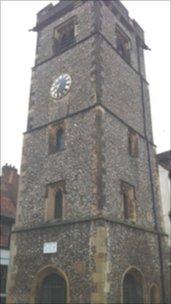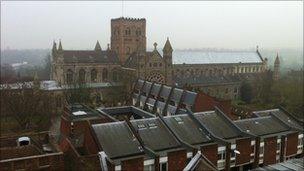St Albans Clock Tower to be renovated
- Published

St Albans Clock Tower was built between 1403 and 1412
One of St Albans' oldest monuments is being renovated.
Vital repairs of the Grade I-listed Clock Tower have begun and are set to last about 10 weeks.
The district council will replace ageing wooden louvre window slats and repoint much of the ancient brickwork.
A full survey of the medieval building, which was built between 1403 and 1412, will also be carried out to secure its long-term future.
It will also help people understand how the Clock Tower was built and how it has been altered over time.
'Wonderful opportunity'
Councillor Sheila Burton, portfolio holder for culture and heritage at St Albans District Council, told BBC Three Counties Radio that it was a unique opportunity to study the tower in detail.
"Putting scaffolding up round the outside is a wonderful opportunity for our historians to find out what's going on," she said.
"When you're doing renovations you're generally inside so you can't observe the outside and the bricks and everything.
"Now they will have scaffolding right the way up to the top and it's a good opportunity to learn a bit more about the tower."
The Clock Tower is a familiar feature in the centre of St Albans but the reason for building it is not certain.
It is thought to be the result of some tension between the people of the town and those at the nearby abbey, Mrs Burton said.
"It's sometimes called the mystery tower because people aren't very sure why it was put up," she said.
"But the consensus of opinion is that the merchants of the town got together [because] they were fed up of being ruled by the abbey.
"They [people at the abbey] controlled the clock and rumour goes that they would stick another 10 minutes or half an hour on the time, just so that the people working in the fields worked a bit longer if it was a nice evening. So it was put up in defiance of the abbey really.
"It was put right outside the abbey gateway and also it's on slightly higher ground than the abbey so even in those days there was a bit of joking going on."
Communication system
Whatever the original reason for its construction, the tower became part of an important communication system which used a series of black and white boards put up at high points across the country.
In the 18th Century, people could communicate from the Clock Tower in St Albans to Dunstable Downs 12 miles further north and, in the other direction, down to the south coast.

The Clock Tower was built on slightly higher ground to St Albans Abbey, Mrs Burton said.
"During the Napoleonic Wars, there was a range of them throughout the country," explained the councillor.
"The theory was that if England was invaded by Napoleon they could pass messages right up to Scotland in ten minutes but the theory was never tested.
"For those times it was a very sophisticated way of messaging, much better than riding [on horseback] between points, telling people that they army was coming."
With councils cutting back on spending, Mrs Burton is aware that people may question why these repairs are being done.
"It belongs to the council and we have a responsibility to look after it," she said.
"It's the only medieval clock tower in England so it's one of a kind."